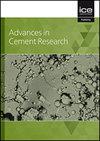用于碱活性材料的替代水玻璃的参数分析
IF 1.3
4区 工程技术
Q3 CONSTRUCTION & BUILDING TECHNOLOGY
引用次数: 0
摘要
尽管碱活化材料被认为是波特兰水泥的潜在替代品,但它们仍然存在成本较高和大量二氧化碳排放的问题。部分克服这一缺点的一种方法是开发替代活化剂,例如基于稻壳灰(RHA)溶解的水玻璃。然而,为了最大限度地发挥碱活化材料的力学性能,需要充分了解rhaa基硅酸钠的生产。本文通过对RHA研磨时间、RHA溶解时间、热固化温度和时间等参数的实验评价,研究了一种替代RHA基水玻璃活化剂的生产工艺。通过对以偏高岭土为前驱体和两种类型的活化剂(基于rhaa的水玻璃钠和商用水玻璃钠)组成的碱活化膏体进行抗压强度试验,评估了其力学性能。显微结构特征通过x射线衍射,扫描电子显微镜和热重分析进行评估。研磨时间为30分钟,热固化温度为40℃,溶解时间为6小时,热固化时间为8小时,得到了最佳产品。结果表明,替代碱性活化剂的有效性,为碱活性材料的大规模应用提供了技术上可行的解决方案。本文章由计算机程序翻译,如有差异,请以英文原文为准。
Parametric analysis of the production of alternative sodium silicate applied in alkali-activated materials
Although alkali-activated materials are considered potential substitutes for Portland cement, they still present elevated costs and significant emissions of CO2. One way to partially overcome this disadvantage is the development of alternative activators, such as a sodium silicate based on the dissolution of rice husk ash (RHA). However, to maximize the mechanical performance of alkali-activated materials, the production of RHA-based sodium silicates needs to be fully understood. This article investigates the production process of an alternative RHA-based sodium silicate activator through the experimental evaluation of the following parameters: RHA grinding time, RHA dissolution time, thermal curing temperature and time. The mechanical performance was evaluated through compressive strength tests carried out on alkali-activated pastes made up of metakaolin, as a precursor, and two types of activators (RHA-based sodium silicate and commercial sodium silicate). Microstructural features were evaluated by performing X-Ray Diffraction, Scanning Electron Microscopy, and Thermogravimetry analyses. The optimized production was obtained for a grinding time of 30 minutes, a thermal curing temperature of 40°C, a dissolution time of 6 hours, and a thermal curing time of 8 hours. The results show the efficiency of the alternative alkaline activator, which may represent a technically viable solution for the larger-scale application of alkali-activated materials.
求助全文
通过发布文献求助,成功后即可免费获取论文全文。
去求助
来源期刊

Advances in Cement Research
工程技术-材料科学:综合
CiteScore
3.70
自引率
5.00%
发文量
56
审稿时长
3.2 months
期刊介绍:
Advances in Cement Research highlights the scientific ideas and innovations within the cutting-edge cement manufacture industry. It is a global journal with a scope encompassing cement manufacture and materials, properties and durability of cementitious materials and systems, hydration, interaction of cement with other materials, analysis and testing, special cements and applications.
 求助内容:
求助内容: 应助结果提醒方式:
应助结果提醒方式:


